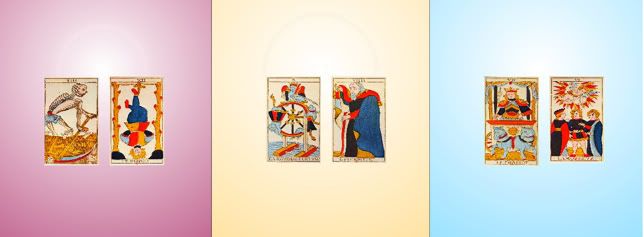There is quite a bit of relevant historical sources related to this card to draw from when finding various applicable correlations to flesh out the
original allegory if one wishes to use the 22 Trumps as a divinatory device.
Trumps VI through XIII (sans virtues) originally simply represented
the cycle of life.
Time and
Fortune are center, the hub around which life rotates. In some ways we can say
Father Time is the turner of the wheel. On the
up swing of the Wheel we have
Love/Pleasure/Youth (VI) and
Fame/Success/Honor (VII) on the
down swing of the Wheel is
Defamation/Failure/Dishonor (XII) and
Death (XIII).
VI and XIII are opposites.
Love (betrothal) was traditionally one's 'coming of age', the beginning of one's life as an adult, so the card represents life and life's pleasures in general. The opposite is
Death. This pairing of
Love and Death as the 'bookends of life' was a common theme in later renaissance/early modern allegory.
VII and XII are opposites. The triumphal parades were a great honor for the citizens of Renaissance Italy. Only successful and well known citizen were aloud the honor of riding in the parade. The XII image is taken from Italian Renaissance 'shame paintings' which were used as a way to dishonor and defame citizens.
Traditionally four figures ride the wheel (in the TdM the fourth is unseen, and unnamed). We can compare these figures to the four cards.
- VI - Regnabo - I Shall Reign.
- VII - Regno - I Reign.
- XII - Regnavi - I Reigned for a While.
- XIII - Sum Sine Regno - I Shall Reign Never More
There is a strong parallel between the Lovers card image, and the representations of
April or
May in the later medieval calendars. We of course can usefully add this traditional association to our 'toolbox'. We can extend the association further -
youth / spring / morning / the early phase of any endeavor or project. We can borrow the traditional association of Spring with
Elemental Aire, and the rich associations found there -
the sanguine temperament, warm & moist, quick response & short duration, etc..
The associations of Love to the goddess of love,
Venus, and her planetary namesake can supply us with a treasure trove of traditional associations from types of jobs, to herbs, stones, and animals.
The link between the Lovers and Spring, and the Lover and Venus opens up the connection to the celestial house of
Taurus, the fixed sign of Spring, ruled by Venus. Though I doubt intentional, this relation to the four
fixed signs and the four
cycle of life cards makes a very tidy and workable fit.
- Spring = Taurus = Ruled by Venus = Love (VI)
- Summer = Leo = Ruled by Sun (Apollo) = Chariot (VII)
- Fall = Scorpio = Ruled by Mars = Ruler of Traitors according to W. Lilly (XII)
- Winter = Aquarius = Ruled by Saturn = Death (XIII)







